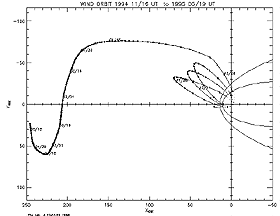Encounters with the Moon

The original plan called for "Wind" to approach its final station over two
years, undergoing two close encounters with the Moon to boost its speed. A spacecraft approaching a stationary
object--like a comet approaching the Sun--increases its speed as it approaches, but after it passes (assuming there has been no collision) it loses again all it had gained.
If however the object is moving, the encounter is not symmetric, and in the end the spacecraft may have gained or lost speed, depending on its trajectory. The encounters of the space probes Voyager 1 and 2 with Jupiter not only helped them explore that giant planet and its magnetosphere, they also gave the Voyagers an extra boost which allowed them to continue to Saturn, where another boost helped Voyager 2 continue to Uranus, Neptune and beyond. "Wind" used the Moon's gravity in a similar manner, as did Geotail.
Note The "gravity-assist" maneuver, in which a spacecraft may gain or lose velocity through an encounter with a moving planets, is discussed in some detail (including calculations) in section #35 "Starships" of the sister-site From Stargazers to Starships. See also article "A Bus Between the Planets" by James Oberg and Buzz Aldrin, "p. 58-60, "Scientific American", March 2000
Instruments and Observations
Some of the instruments aboard Wind measure properties of the solar wind
plasma--for instance, the speed of its flow, the flow's direction (it can vary by a few degrees) and the distribution of electron and ion energies. They also measure the proportions of various ions in the solar wind:
protons and alpha-particles form the great majority, but the stream also includes the
rarer isotopes of "heavy" hydrogen and "light" helium, as well as carbon, oxygen and other
elements. The variation of these proportions can shed light on processes in the Sun's corona, where the solar wind originates.
Radio wave receivers monitor emissions from the Sun and from space plasmas, and
a magnetometer samples the interplanetary magnetic field (IMF) up to 44 times a
second. Because
the IMF is very weak (about 1/10,000 the Earth's surface field), the magnetic
fields produced by
electric currents on the spacecraft are strong enough to disturb its
observation, and the
magnetometer is therefore placed (here and on most deep-space spacecraft) at the
end of a long
boom, away from the interference.
"Wind" also carries two gamma ray detectors, to observe and time gamma ray
bursts from distant
space, probably beyond our galaxy (more on them in the section on high energy particles in the universe
Update December 1998
At the end of 1997, WIND rounded the L1 Lagrangian point and headed back to
Earth. With the ACE spacecraft now positioned near L1, capable of routine monitoring of the solar wind, WIND with its unique capabilities can be positioned elsewhere, providing broader coverage of the solar wind as we approach the next sunspot maximum, around 2000-2001. The new set of orbits is achieved by flying near the moon and using its gravity to alter the spacecraft trajectory.
As of the end of 1998, the new mission is well under way, with "WIND" in its new "petal orbits" which explore the magnetosheath at points abreast of the magnetosphere but relatively distant from the ecliptic. For additional details and updates, see the home
page of the "Wind" mission.
Update December 2001
The ISTP project officially ended in October 2001.. The "Wind" spacecraft continues in a supporting role, and scientific collaboration continues between researchers of "Polar", the reflight of Europe's "Cluster" and Japan's "Geotail", as well as the more recent "Image" mission, solar monitors on "SOHO" and solar wind monitors on "ACE."

